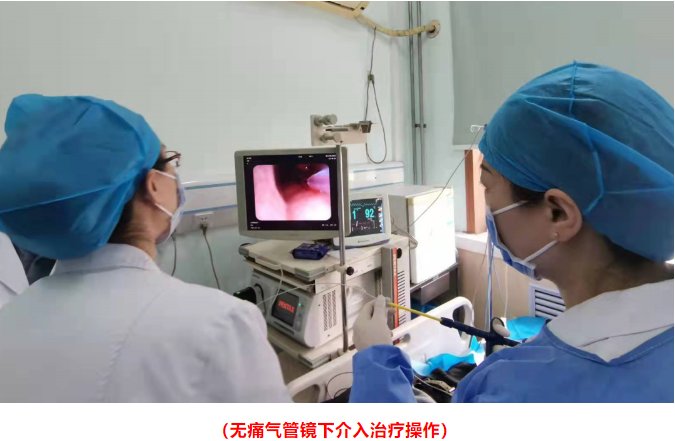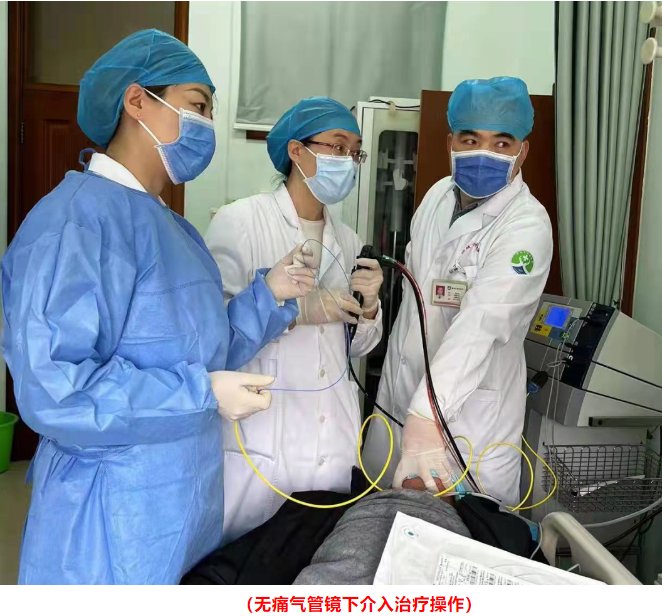On March 29, the Department of Respiratory and Critical Care Medicine of Liaocheng Cancer Hospital successfully completed the first painless bronchoscopy interventional ablation of tracheal tumor in the hospital, filling the gap in the hospital in related fields and marking the hospital’s respiratory endoscopy Minimally invasive interventional diagnosis and treatment technology has reached a new level.

Citizen Uncle Zhou, suffering from left lung squamous cell carcinoma and esophageal cancer, has undergone surgery and radiotherapy in other hospitals before. On March 26, he came to the Department of Respiratory and Critical Care Medicine of Liaocheng Cancer Hospital for examination and treatment because of “blood in sputum”. After intensive CT examination of the lungs, it was found that Uncle Zhou’s main trachea had a visible diameter of about 1.5cm. Nodular foci, markedly enhanced after enhancement. Subsequently, bronchoscopy was performed on the patient, and it was found that a mass of about 1.5 cm in diameter was seen in the middle of the trachea, blocking nearly half of the airway. With the enlargement of the tumor, Uncle Zhou is very likely to have massive hemoptysis and blockage of the large airway in the future, causing life-threatening. Considering that the patients are older, have more underlying diseases, traditional surgical operations are more traumatic, and the postoperative recovery time is long. After expert consultation and detailed communication with family members, it was decided to perform minimally invasive interventional therapy under painless bronchoscopy for the patient under general anesthesia.
This surgical technique is advanced, difficult, and highly demanding for doctors. Currently, it is rarely performed in medical institutions in our city. In order to ensure the smooth operation, directors Xu Yangling and Ji Xiangbin fully assessed the risks of the operation and formulated the operation and intraoperative risk rescue plan to minimize the risk of the operation.

On March 29, Xu Yangling, deputy chief physician of the Department of Respiratory and Critical Care, and Ji Xiangbin, director of the Department of Anesthesiology, performed minimally invasive intervention under general anesthesia under bronchoscopy. Treatment (high-frequency electric snare, argon gas knife to remove tumor, cryoprobe to remove tumor and cryotherapy of residual lesions). The tumor was excised about 1.5 cm in size. The operation went well, the patient’s hemoptysis was significantly reduced after the operation, and the breathing became more smooth. The excised tumor was diagnosed as squamous cell carcinoma by pathological examination. The smooth development of minimally invasive interventional therapy under bronchoscopy marks that the hospital’s endoscopic interventional technology is at the first-class level in the city.
The Department of Respiratory and Critical Care Medicine of Liaocheng Cancer Hospital, with respiratory intervention as its development feature, cooperates closely with the Department of Anesthesiology and other disciplines to routinely conduct painless bronchoscopy for patients with pulmonary tumors. Successfully completed several cases of transbronchial interventional treatment of lung tumors under general anesthesia, providing more experience and methods for the diagnosis and treatment of respiratory diseases in our city, and escorting the health of people in Liaocheng and surrounding areas.
Small popular science: The incidence of bronchial lung cancer ranks first among malignant tumors in China, and 80% of them have lost the chance of surgery at the time of discovery. Some patients have airway masses that block the airway, intractable cough, hemoptysis, and dyspnea. , causing great suffering to patients. Interventional therapy with high-frequency electrosurgical knife and argon gas knife through bronchoscopy, combined with cryotherapy if necessary, can quickly resolve airway blockage, allow patients to breathe smoothly, prolong their life, and improve their quality of life. On the other hand, bronchoscopy interventional therapy is minimally invasive, with low cost and high safety. Combined with intravenous anesthesia, patients can complete the treatment without pain. It is also a suitable method for early-stage lung cancer limited to the bronchial wall, such as those who are not suitable for surgical treatment due to advanced age, poor cardiopulmonary function or other reasons.